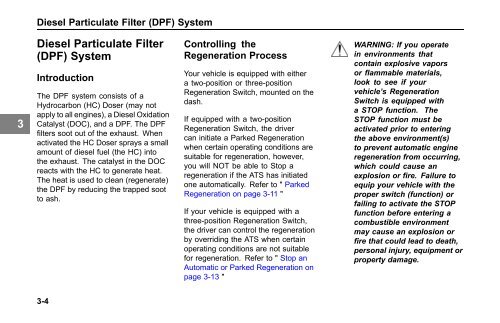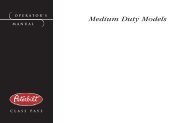PACCAR Engine Aftertreatment Systems-Operator's Manual
PACCAR Engine Aftertreatment Systems-Operator's Manual
PACCAR Engine Aftertreatment Systems-Operator's Manual
Create successful ePaper yourself
Turn your PDF publications into a flip-book with our unique Google optimized e-Paper software.
Diesel Particulate Filter (DPF) System<br />
3<br />
Diesel Particulate Filter<br />
(DPF) System<br />
Introduction<br />
The DPF system consists of a<br />
Hydrocarbon (HC) Doser (may not<br />
apply to all engines), a Diesel Oxidation<br />
Catalyst (DOC), and a DPF. The DPF<br />
filters soot out of the exhaust. When<br />
activated the HC Doser sprays a small<br />
amount of diesel fuel (the HC) into<br />
the exhaust. The catalyst in the DOC<br />
reacts with the HC to generate heat.<br />
The heat is used to clean (regenerate)<br />
the DPF by reducing the trapped soot<br />
to ash.<br />
Controlling the<br />
Regeneration Process<br />
Your vehicle is equipped with either<br />
a two-position or three-position<br />
Regeneration Switch, mounted on the<br />
dash.<br />
If equipped with a two-position<br />
Regeneration Switch, the driver<br />
can initiate a Parked Regeneration<br />
when certain operating conditions are<br />
suitable for regeneration, however,<br />
you will NOT be able to Stop a<br />
regeneration if the ATS has initiated<br />
one automatically. Refer to " Parked<br />
Regeneration on page 3-11 "<br />
If your vehicle is equipped with a<br />
three-position Regeneration Switch,<br />
the driver can control the regeneration<br />
by overriding the ATS when certain<br />
operating conditions are not suitable<br />
for regeneration. Refer to " Stop an<br />
Automatic or Parked Regeneration on<br />
page 3-13 "<br />
WARNING: If you operate<br />
in environments that<br />
contain explosive vapors<br />
or flammable materials,<br />
look to see if your<br />
vehicle’s Regeneration<br />
Switch is equipped with<br />
a STOP function. The<br />
STOP function must be<br />
activated prior to entering<br />
the above environment(s)<br />
to prevent automatic engine<br />
regeneration from occurring,<br />
which could cause an<br />
explosion or fire. Failure to<br />
equip your vehicle with the<br />
proper switch (function) or<br />
failing to activate the STOP<br />
function before entering a<br />
combustible environment<br />
may cause an explosion or<br />
fire that could lead to death,<br />
personal injury, equipment or<br />
property damage.<br />
3-4

















